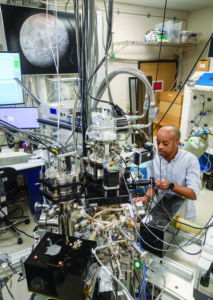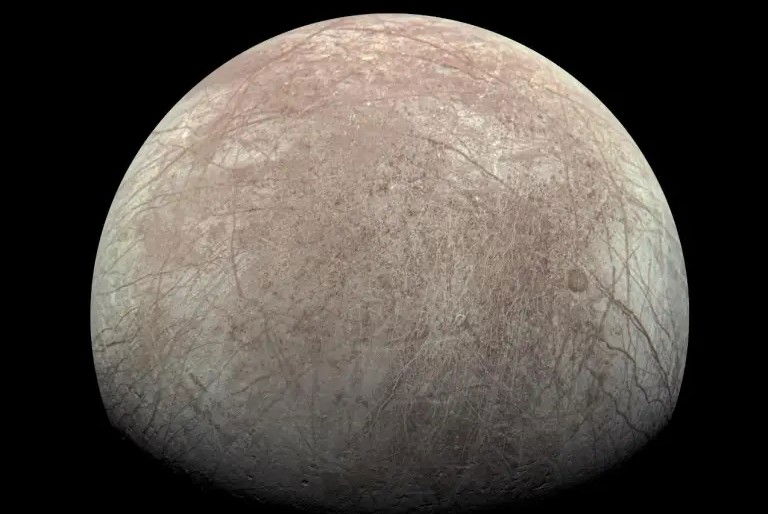Scientists from the Southwest Research Institute (SWRI) have conducted a series of experiments that could explain observations of hydrogen peroxide on the surface of Jupiter’s moon Europa made by the James Webb Space Telescope.
Previous studies suggested that hydrogen peroxide would be found in higher concentrations in the polar regions where temperatures are lowest. However, observations by the JWST of the moon’s warmer equatorial chaos terrain known as Tara Regio found concentrations to be significantly higher than the poles, leaving scientists unable to explain the puzzling discrepancy.
The researchers said their experiments could improve the chances of a subsurface ocean beneath the moon’s icy crust, potentially capable of supporting extreme lifeforms.
Simulated Europa Offers Clues into Puzzling Hydrogen Peroxide
According to a statement from the SWRI research team, these “puzzling observations” inspired Bereket Mamo, a graduate student at The University of Texas at San Antonio and a SwRI contractor, to propose a series of NASA-funded experiments to “investigate the mystery.” Based on that proposal, NASA awarded Mamo a Future Investigators in NASA Earth and Space Science and Technology grant to fund the experiments.
 UTSA Graduate Student Bereket Mamo works Monday, Oct. 21, 2024, in the Southwest Research Institute Space Science Division (16) Center for Laboratory Astrophysics and Space Science Experiments. The CLASSE lab has the niche resources to develop such new capabilities to specifically address outstanding chemical questions in interstellar, cometary and Europan environments.
UTSA Graduate Student Bereket Mamo works Monday, Oct. 21, 2024, in the Southwest Research Institute Space Science Division (16) Center for Laboratory Astrophysics and Space Science Experiments. The CLASSE lab has the niche resources to develop such new capabilities to specifically address outstanding chemical questions in interstellar, cometary and Europan environments.
After collaborating with colleagues from the SwRI’s Center for Laboratory Astrophysics and Space Science Experiments (CLASSE) facility, they analyzed chemical data captured by the JWST of the equatorial chaos terrains. Along with the puzzling observations of hydrogen peroxide, the data also contained evidence of elevated carbon dioxide (CO2) levels. Previous analyses suggested that CO2 was “seeping up” through cracks in the planet-wide ice crust from a possible ocean of liquid seawater.
To approximate the environment in Europa, the team deposited a mixture of water ice and CO2 in a vacuum chamber. According to Mamo, they “irradiated” the mixture with energetic electrons to observe changes in the production of peroxide.
 The SWRI team used a vacuum chamber to simulate the surface of Europa where high levels of hydrogen peroxide were detected by the JWST. Southwest Research Institute.
The SWRI team used a vacuum chamber to simulate the surface of Europa where high levels of hydrogen peroxide were detected by the JWST. Southwest Research Institute.
An analysis of the environment within the chamber revealed elevated hydrogen peroxide levels, similar to the puzzling equatorial levels observed by the JWST on Europa. The team said the discovery that even trace amounts of CO2 in water can “significantly enhance” hydrogen peroxide production could explain the previous observations.
“These findings provide a plausible explanation for the perplexing hydrogen peroxide distribution on Europa,” the statement explained.
The team said their findings have implications for understanding the presence of hydrogen peroxide in the presence of CO2 on the solar system’s other icy bodies that may also have subsurface bodies of water, such as Jupiter’s moon Ganymede, two of Saturn’s other moons, Enceladus and Mimas, and Pluto’s moon Charon.
Impact on Potential Life in Moon’s Subsurface Ocean
Dr. Ujjwal Raut, program manager in SwRI’s Planetary Science Section and Mamo’s advisor, noted that a key factor driving their research was previous observations of Europa, which indicated that the moon may have a subsurface ocean capable of supporting biological life. If the puzzling amount of CO2 spotted by the JWST is a result of water seeping up to the surface, Raut said this could hint at a chemical cycle involving irradiation of the seawater, which creates a “chemical potential” of oxidants, including hydrogen peroxide.
Richard Cartwright from Johns Hopkins University Applied Physics Laboratory and a co-author of the paper said the synthesis of hydrogen peroxide and other oxidants on the moon’s surface “is important from an astrobiological point of view.”
“In fact, an entire NASA mission, the Europa Clipper, is en route to the Jovian system right now to explore the icy moon and help us understand Europa’s habitability,” he said.
Across geological timescales, peroxides can theoretically cycle back into the subsurface ocean where they could react with reductants coming from the seafloor. Such reactions would release chemical energy that lifeforms that do not rely on the presence of direct sunlight could theoretically use to survive. On Earth, many examples of such lifeforms are called “extremophiles.”
“When you have a source of carbon from the interior, such as from an interior ocean like on Europa, and you combine it with energy coming from the magnetosphere, it produces new species on the surface, including hydrogen peroxide and other organic compounds, that store chemical energy,” explained Dr. Ben Teolis, a planetary scientist at SwRI and another co-author of the paper. “Chemical energy is important because it is a necessary ingredient for the dark habitable ocean worlds where the sun doesn’t shine.”
Cartwright said the team’s experiments “provide clues” into the puzzling observations of hydrogen peroxide in Europa’s equatorial regions first spotted by the JWST, “and serve as a prelude to upcoming close-range investigations by Europa Clipper and ESA’s JUICE spacecraft.”
The study “Laboratory Investigation Of CO2-Driven Enhancement Of Radiolytic H2O2 On Europa And Other Icy Moons” was published in the Planetary Science Journal.
Christopher Plain is a Science Fiction and Fantasy novelist and Head Science Writer at The Debrief. Follow and connect with him on X, learn about his books at plainfiction.com, or email him directly at christopher@thedebrief.org.

